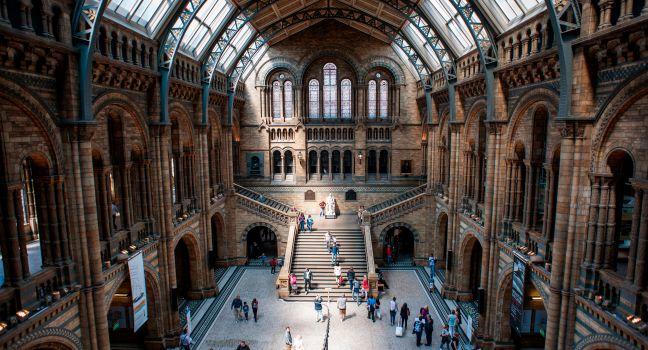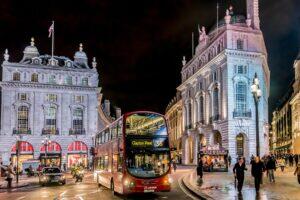Fodor's Expert Review Natural History Museum

Originally built to house the British Museum’s natural history collection and bolstered by samples provided by Britain’s great 19th-century explorers and scientists—notably Charles Darwin—this enormous Victorian cathedral of science is one of the world’s preeminent museums of natural history and earth sciences. As might be expected given its Darwin connection, the emphasis is on evolution and conservation. The terra-cotta facade is embellished with relief panels depicting living creatures to the left of the entrance and extinct ones to the right (although some species have subsequently changed categories). Most are represented inside the museum, which contains more than 70 million different specimens. Only a small percentage is on public display, but you could still spend a day here and not come close to seeing everything.
The skeleton of a giant blue whale dominates the vaulted, cathedral-like entrance hall. Even bigger than the blue whale is the skeleton of titanosaur Patagotitan... READ MORE
Originally built to house the British Museum’s natural history collection and bolstered by samples provided by Britain’s great 19th-century explorers and scientists—notably Charles Darwin—this enormous Victorian cathedral of science is one of the world’s preeminent museums of natural history and earth sciences. As might be expected given its Darwin connection, the emphasis is on evolution and conservation. The terra-cotta facade is embellished with relief panels depicting living creatures to the left of the entrance and extinct ones to the right (although some species have subsequently changed categories). Most are represented inside the museum, which contains more than 70 million different specimens. Only a small percentage is on public display, but you could still spend a day here and not come close to seeing everything.
The skeleton of a giant blue whale dominates the vaulted, cathedral-like entrance hall. Even bigger than the blue whale is the skeleton of titanosaur Patagotitan mayorum, one of the largest creatures to have ever walked the Earth, now housed in the Waterhouse Gallery (£16). Meanwhile, similarly huge dino bones (technically rocks due to fossilization) can be found in the Dinosaur Gallery (Blue Zone) along with the only known fossil of Spicomellus, a type of armored dinosaur with spikes protruding from its ribs. You'll also come face-to-face with a virtual Jurassic sea dragon and a giant animatronic T. rex (¾ of its actual size) that's programmed to sense when human prey is near and "respond" in character. When he does, you can hear the shrieks of fear and delight all the way across the room.
An escalator takes you into a giant globe in the Earth Galleries, where there's a choice of levels to explore. Don't leave without checking out the earthquake simulation in the Volcanoes and Earthquakes Gallery. The Darwin Centre houses some 80 million items the museum itself doesn't have room to display, including "Archie," a 28-foot giant squid. If you want to see Archie and some of the other millions of animal specimens preserved (including some acquired on Darwin's Beagle voyage), you'll need to book one of the behind-the-scenes Spirit Collection tours (£25). These 45-minute tours take place at various dates and times and can be booked on the same day (space is limited, so come early). Night owls might prefer one of the evening talks or spending an entire night in the museum at one of the "Dino Snores" events (extra charge applies).
The museum also has an outdoor ice-skating rink from October through January and a popular Christmas fair.
READ LESS








